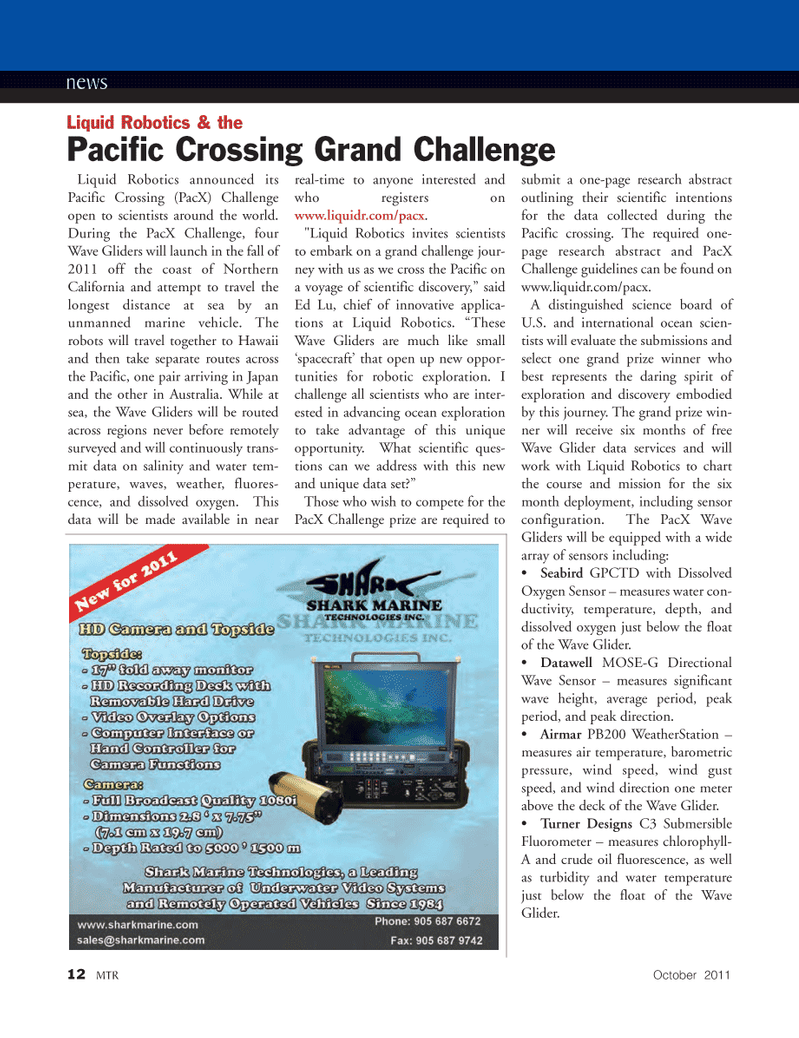
Page 12: of Marine Technology Magazine (October 2011)
Ocean Engineering & Design
Read this page in Pdf, Flash or Html5 edition of October 2011 Marine Technology Magazine
12MTROctober 2011Liquid Robotics announced its Pacific Crossing (PacX) Challenge open to scientists around the world. During the PacX Challenge, four Wave Gliders will launch in the fall of 2011 off the coast of Northern California and attempt to travel the longest distance at sea by an unmanned marine vehicle. The robots will travel together to Hawaii and then take separate routes across the Pacific, one pair arriving in Japan and the other in Australia. While at sea, the Wave Gliders will be routed across regions never before remotely surveyed and will continuously trans- mit data on salinity and water tem-perature, waves, weather, fluores- cence, and dissolved oxygen. This data will be made available in near real-time to anyone interested and who registers on www.liquidr.com/pacx . "Liquid Robotics invites scientiststo embark on a grand challenge jour- ney with us as we cross the Pacific on a voyage of scientific discovery,? said Ed Lu, chief of innovative applica- tions at Liquid Robotics. ?These Wave Gliders are much like small ?spacecraft? that open up new oppor- tunities for robotic exploration. I challenge all scientists who are inter- ested in advancing ocean exploration to take advantage of this unique opportunity. What scientific ques- tions can we address with this new and unique data set?? Those who wish to compete for thePacX Challenge prize are required to submit a one-page research abstract outlining their scientific intentionsfor the data collected during thePacific crossing. The required one- page research abstract and PacX Challenge guidelines can be found onwww.liquidr.com/pacx. A distinguished science board of U.S. and international ocean scien-tists will evaluate the submissions and select one grand prize winner who best represents the daring spirit of exploration and discovery embodied by this journey. The grand prize win- ner will receive six months of free Wave Glider data services and will work with Liquid Robotics to chart the course and mission for the sixmonth deployment, including sensor configuration. The PacX Wave Gliders will be equipped with a wide array of sensors including:Seabird GPCTD with Dissolved Oxygen Sensor ? measures water con- ductivity, temperature, depth, and dissolved oxygen just below the float of the Wave Glider. Datawell MOSE-G Directional Wave Sensor ? measures significant wave height, average period, peak period, and peak direction. Airmar PB200 WeatherStation ? measures air temperature, barometric pressure, wind speed, wind gust speed, and wind direction one meter above the deck of the Wave Glider. Turner Designs C3 Submersible Fluorometer ? measures chlorophyll- A and crude oil fluorescence, as well as turbidity and water temperature just below the float of the Wave Glider. news Liquid Robotics & thePacific Crossing Grand Challenge MTR#8 (1-17):MTR Layouts 10/11/2011 9:48 AM Page 12

 11
11

 13
13
